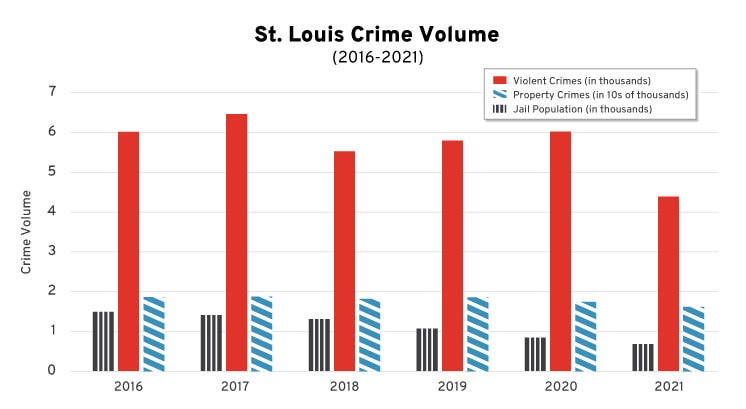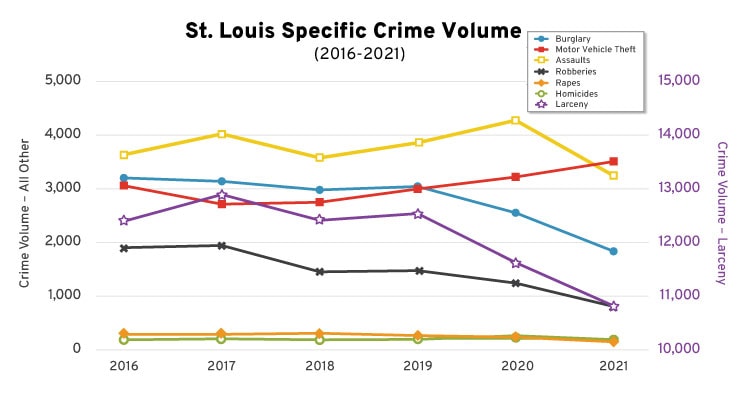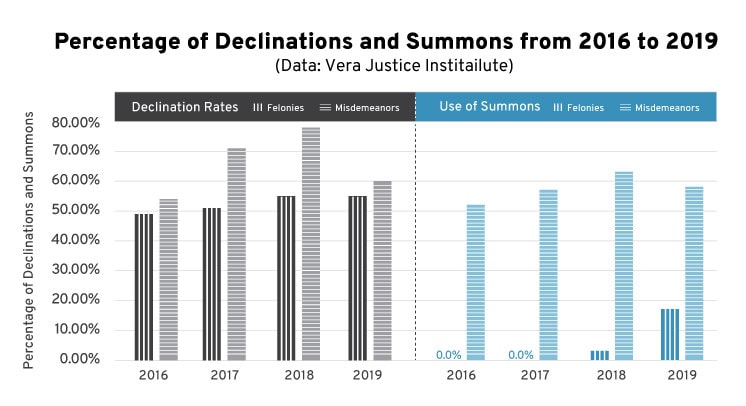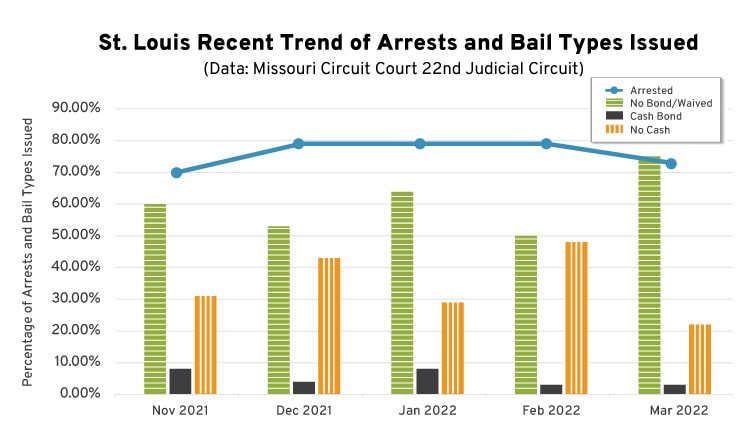Criminal Justice Reform Efforts and Rise in Crime: Spotlight on City of St. Louis, Mo.
This is the third in a series of posts on the subject. Scroll to the end to see the most recent posts in the series.
Introduction
The nation has been captivated by reports of rising crime and the wave of criminal justice reform. Some news outlets and elected officials claim a correlation between the two, but this is perhaps a hasty assessment. In order to better understand how criminal justice reform efforts could be affecting increases in crime, we will be digging into the data, history and current criminal justice reform efforts of six Safety and Justice Challenge sites across the United States. Readers can learn about unique criminal justice reform initiatives in these communities as well as whether the implementation of these efforts (or lack thereof) could be associated with an increase or decrease in crime. To learn more about this series, you can access the introduction here.
Location Information
The City of St. Louis, Mo., is known for manufacturing industries, the Gateway Arch and baseball. As the second largest city in Missouri, St. Louis is home to approximately 300,000 people. The St. Louis Metropolitan Police Department covers 62 square miles.
Crime Statistics
Disclaimer: The St. Louis Metropolitan Police Department changed their data collection system from the Uniform Crime Reporting (UCR) to the National Incident Based Reporting System (NIBRS) in 2021, which could have affected some of the numbers reported in 2021.
From 2016 to 2021, property crimes in St. Louis saw an overall decrease. Violent crime remained fairly consistent over the six-year period with a significant decrease in 2021. St. Louis’s average daily jail population has been falling since 2016. Using data collected by the Missouri State Highway Patrol, the chart below shows trends from the St. Louis Metropolitan Police Division.

Murder rates have had spikes and valleys over the last six years—increasing in 2017, decreasing in 2018, increasing in 2019 and 2020, and then decreasing in 2021. Notably, law enforcement classified a much larger number of killings in 2021 as justified than they did in previous years; however, even including these justified killings, the murder rate still declined from 2020. Rapes, robberies and burglaries hit a peak in 2017 and 2018 and then consistently fell through 2021. Similarly, larceny has fallen since its peak in 2016, but saw a slight increase in 2021 from 2020. Conversely, assaults and motor vehicle thefts were at a low in 2016, followed by a significant increase through 2021. The chart below depicts these trends using data from the St. Louis Metropolitan Police Division.

Criminal Justice Reform Efforts
Missouri has enacted a few reform measures such as bill HB192, which changes some mandatory minimums for habitual offenders and bill SB5, which limits confinement for minor traffic violations following the killing of Michael Brown by a Ferguson, Mo. police officer during a traffic stop. St. Louis has also worked to implement local reforms such as a drug court, prosecutorial diversion and “Cure Violence,” a program designed to stop the spread of violence. In April 2022, the City of St Louis worked with the Center for Policing Equity to conduct a comprehensive assessment and provided several recommendations in their Reimagining Public Safety in the City of St. Louis: A Vision for Change report. Below, we have highlighted three already-implemented St. Louis criminal justice reform initiatives that help reduce jail populations.
Crisis Intervention:
- In February 2021, the City of St. Louis implemented two crisis intervention initiatives using $860,000 from the jail budget. Cops and Clinicians is a co-responder program in which mental health clinicians respond to certain behavioral health calls with patrol officers. St. Louis also started a 911 call diversion program which diverts some calls to crisis counselors and mental health specialists who can provide support over the phone. The main purpose of these efforts is to divert individuals from the criminal justice system and instead get them into necessary treatment. The program not only helps diffuse situations and connect individuals with ongoing resources, but also assists police officers that generally do not have specific education or experience dealing with behavioral health issues. In the first eight months of the program, the Cops and Clinicians teams have responded to nearly 5,000 cases, diverting 95 percent of individuals from arrest and 87 percent from hospitalization. A study completed on the program estimates the community saved more than $2.2 million in 2021.
Prosecutorial Reform
- In 2017, the Circuit Attorney’s Office started to work with Vera Institute of Justice to collect and analyze data and then provided recommendations—in “Reshaping Prosecution in St. Louis: Lessons from the Field”—to end mass incarceration, reduce racial disparities and help the office be more accountable and transparent. As a result, the Circuit Attorney’s Office updated procedures for cases taken under advisement and dismissed 25,000 cases that were pending without charges. The Circuit Attorney also created a policy requiring that all misdemeanors (other than domestic violence) and low-level felonies presumptively receive a summons rather than prompting an arrest. However, data shows that the majority of accused individuals in St. Louis are still arrested instead of cited into court: 70 to 79 percent from Nov. 2021 to Mar. 2022. While this number is concerning, it could also be a result of the Circuit Attorney’s office declining more low level offenses; for example, St. Louis no longer prosecutes low-level marijuana crimes that previously took up 20 percent of a prosecutor’s caseload. The graph below, using data collected by the Vera Justice Institute, shows the percentage of summons and declinations from 2016 to 2019.

Pretrial Release
- On July 1, 2019 (revised Jan. 1, 2020), the Missouri Supreme Court announced bail reforms for the state. The mandate requires courts to release an individual on their own recognizance—with no monetary condition—unless it is necessary to secure the appearance of the person at court hearings or if a safety concern exists. If the court imposes bail conditions, they must be the least restrictive option needed to secure the appearance of the defendant or to protect public safety. If, by clear and convincing evidence, the court finds the defendant a flight risk or a threat to public safety, the court can order the defendant to be held without bail. Unfortunately, despite (or in response to) these efforts, a substantial number of individuals are being detained pretrial in St. Louis. A large number of accused individuals get placed on a no bond hold (including those that waived bond) at their first appearance: 50 to 75 percent from Nov. 2021 to Mar. 2022. This may be a result of limited pretrial assessment and supervision services that leave the court with only two options: detainment or unsupervised release. The negative impacts of incarceration—even for a day—on an individual and the community’s economics, well-being and safety are well documented. One promising pretrial release program still in its infancy provides a needs assessment for individuals arrested and refers the individual to community services to address root causes. Below is a graph, using data from the Missouri Circuit Court 22nd Judicial Circuit, that shows the recent trend of arrests and bail types issued.

The results of a January 2022 poll showed bipartisan support for criminal justice reforms. It appears that St. Louis and the Circuit Attorney’s Office have taken (and continue to take) steps to provide more mental health crisis support and reduce jail populations. Some of these initiatives can reduce repeat calls, increase public safety and save taxpayer dollars. However, the high level of arrests being declined for prosecution and the only diversion programs being offered post-arrest may subject individuals to the negative impacts of incarceration with limited-to-no support and resources. The state has been slower to take any action on other reforms like expanding citation authority or codifying bail reform. Instead, the state has made other policy changes—such as repealing the requirement for gun permits—that others have attributed to a rise in crime.
Conclusion
Just seven years ago, St. Louis was jailing people at twice the rate of the national average, imprisoning people at nearly three times the average rate, and experiencing the most homicides per capita of any large city. It is clear that the “tough-on-crime” approach was not working.
The data evaluated in this paper shows that the implementation of local reforms did not result in an increase in violent crimes (including murders, rapes, robberies and assaults) or in burglaries and thefts in St. Louis. Rather, if St. Louis implements recommended reforms—such as pre-arrest diversion strategies—or makes current efforts more robust, outcomes could actually improve. However, there is a question as to whether reform efforts (as implemented) could be related to an increase in motor vehicle thefts.
Over the last two years, rapes, robberies and burglaries declined significantly. In fact, rapes and robberies reduced by more than 50 percent in 2021 from highs within a six-year period, and burglaries by 42 percent. While larceny did not see as significant of a decrease, the crime rate has been on a downward trend, reaching a six-year low in 2021. Given these statistics, it is reasonable to conclude that these crimes could not have increased due to reform efforts during that period of time.
In contrast, murder and assault rates have been cycling up and down over the last six years. Prosecutorial declinations for felonies increased in 2017 and the use of summons for felonies increased in 2018 and 2019; however, murder and assault rates both increased and decreased during this time, confuting any connection. While the initial increase in murders and assaults seems to correlate with bail reform, the drastic decrease the following year challenges this conclusion; murder and assault rates decreased substantially after the implementation of crisis intervention efforts, indicating a correlation with reduced crime, if anything.
Motor vehicle thefts fell from a high in 2016 for two years, but gradually increased from 2018 until they hit a six-year high in 2021. These trends do appear to correspond with bail reform, prosecutorial declination of felony charges, the higher issuance of felony summonses and crisis intervention efforts. Research indicates that the declination of charges, summonses and release without monetary conditions are not generally employed in motor vehicle theft cases. However, this relationship needs to be further explored to identify whether individuals committing motor vehicle thefts had pending charges at the time or had charges recently declined against them.
St. Louis would benefit from analyzing the data to determine whether their efforts are having their intended effect. St. Louis should also look to implement or grow supervision, support and services to individuals released pretrial or through other diversion options.
This post will be updated with links to each part in the series.
- Criminal Justice Reform Efforts and Rise in Crime: Introduction
- Criminal Justice Reform Efforts and Rise in Crime: Spotlight on Broward County, Fla.
- Criminal Justice Reform Efforts and Rise in Crime: Spotlight on Clark County, Nev.
- Criminal Justice Reform Efforts and Rise in Crime: Spotlight on City of St. Louis, Mo.
- Criminal Justice Reform Efforts and Rise in Crime: Spotlight on Allegheny County, Pa.
- Criminal Justice Reform Efforts and Rise in Crime: Spotlight on Baton Rouge, La.
- Criminal Justice Reform Efforts and Rise in Crime: Spotlight on Missoula, Mont.
- Criminal Justice Reform Efforts and Rise in Crime: Conclusion







